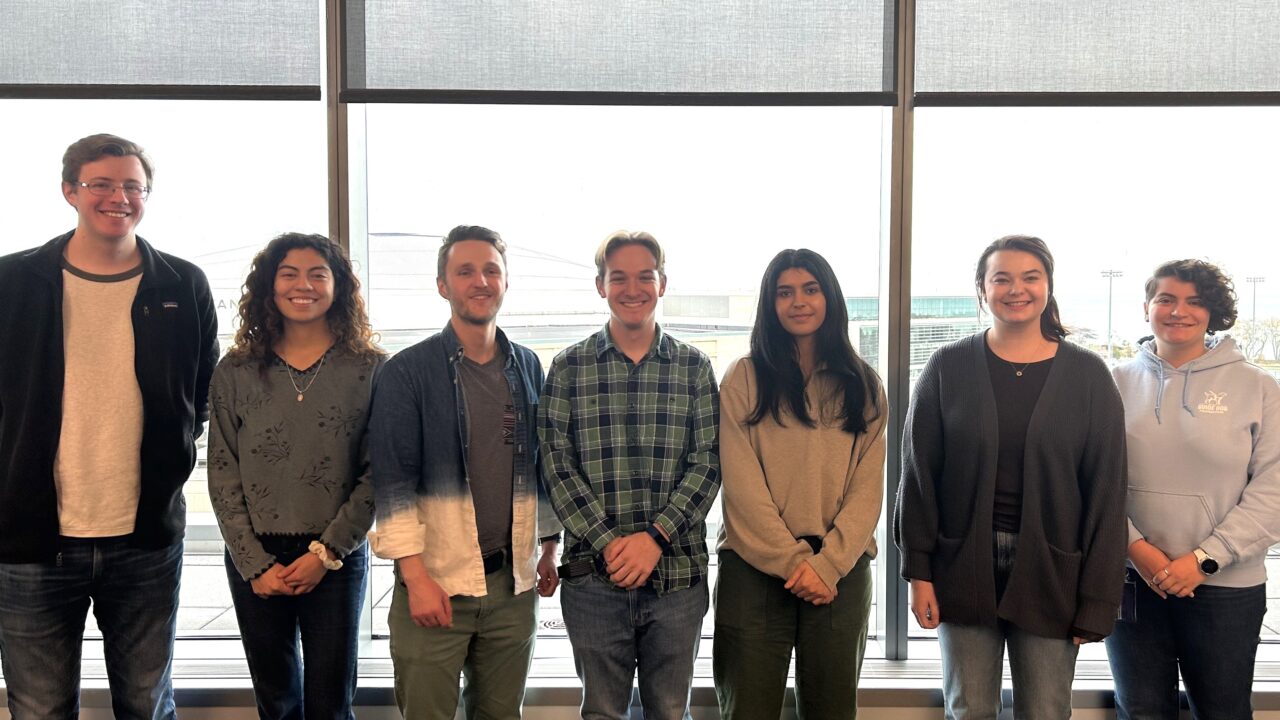Combatting drug resistance, making biomanufacturing more sustainable and developing more versatile drug delivery vehicles are just a few of the ambitious projects led by Northwestern McCormick School of Engineering graduate students in the Center for Synthetic Biology’s PhD training program, Synthesizing Biology Across Scales (SynBAS). The National Science Foundation-funded National Research Traineeship program teaches the principles of living systems across scales – from molecules and cells to organisms and communities.
“Synthetic biologists need training that allows them to traverse and integrate disciplines and biological scales to be successful. The goal of SynBAS is to provide a holistic way of thinking and common language around synthetic biology in order prepare the world’s next leaders in the field,” said Ashty Karim, CSB Director of Research and SynBAS Faculty Member.
In addition to financial support, SynBAS provides trainees from diverse backgrounds with communications training, career mentoring, and networking opportunities for the seven current students selected for the program. Many of the NRT’s programs and initiatives include the courses, workshops, retreats and community events that are open to all CSB students and postdocs at Northwestern.
The Center’s 2024 SynBAS trainees, Geoffrey Bonnanzio, Christina Catlett, Annie Gomez, Maram Naji, Zachary Shaver, Keren Sneh and Cole Wilson, are pursuing a diverse range of research projects that utilize synthetic biology methods and technologies to create a cleaner and healthier world.
Their specific research interests and projects are as follows:
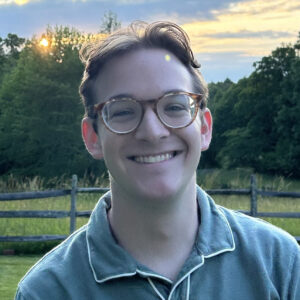 GEOFFREY BONNANZIO
GEOFFREY BONNANZIO
Graduate Program: Chemical & Biological Engineering
Research Lab: Keith Tyo/Linda Broadbelt
Please describe your NRT research project.
My project aims to expand the use of enzymes as effective catalysts to enhance biomanufacturing. I do this by trying to better quantify enzyme promiscuity, the tendency of enzymes to catalyze reactions similar to, but distinct from their native reactions. I use a computational chemistry method called density functional theory to predict a possible range of substrates that enzymes can catalyze. I apply my workflow to carboligases, a class of carbon-carbon bond-forming enzymes that are increasingly important to the pharmaceutical and chemical industries.
What do you hope to learn?
The ultimate goal of my project is to determine why some substrates are incompatible with certain enzymes and determine how we can better engineer those enzymes to catalyze non-native reactions. Additionally, through my project and this training program, I hope to show that small changes at the molecular level can have significant consequences across the biological scales. If enhanced enzyme activity is limiting to cell growth, can we balance the two to create a more efficient biocatalyst?
What potential impact could your project have on society?
By better characterizing carboligase activity we can expand biomanufacturing as a suitable alternative to traditional chemical catalysis which often requires fossil-based feedstocks. As we seek to shift away from these harmful and depleting precursors, my project offers a way to expand our feedstocks to simple, common metabolites such as sugar, and transform them into valuable building blocks for drugs, fuels, and commodity chemicals.
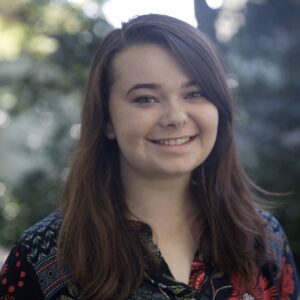 CHRISTINA CATLETT
CHRISTINA CATLETT
Graduate Program: Engineering Sciences & Applied Mathematics
Research Lab: Niall Mangan
Please describe your NRT research project.
While spatial organization of metabolic systems is a promising technique to overcome current hindrances in bioengineering, building and constraining kinetic models to characterize such systems remains a critical challenge. I work with Dr. Niall Mangan on data-driven methods to optimally design experiments and learn dynamic models for spatially organized metabolism. Collaborating with Dr. Danielle Tullman-Ercek, I study the 1,2-propanediol utilization (pdu) microcompartment as a testbed to explore how mathematical identifiability and data informativity can help us to better design model selection algorithms to answer questions and diagnose implementation issues in bioengineering.
What do you hope to learn?
As I come from a math background, I hope to not only learn the underlying biology of the pdu microcompartment and how spatial organization impacts pathway flux, but also how to best work with experimental collaborators and data. I want to learn the extent to which data can inform the complexity of mathematical models and how to identify the most relevant data for answering biological questions of interest.
What potential impact could your project have on society?
Developing a pipeline to design information-optimal experiments and learn metabolic dynamics will remove current limitations on model-building and ease experimental load. This, in turn, has the potential to streamline the quantitative characterization of metabolism for faster prototyping and simplified troubleshooting of biomanufacturing methods used to create sustainable materials, biosensors, alternative fuels, and more. Personally, I am passionate about environmental justice causes, so I hope my research can support biotechnologies that address these issues.
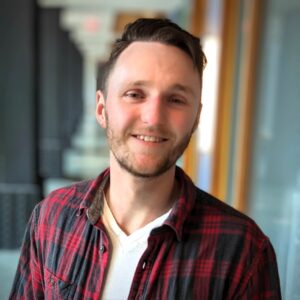
COLE WILSON
Graduate Program: Interdisciplinary Biological Sciences Graduate Program / Civil & Environmental Engineering
Research Lab: Erica Hartmann
Please describe your NRT research project.
My NRT research project involves engineering a virus (also known as bacteriophage or “phage”) that infects the bacteria Pseudomonas aeruginosa, which is a human pathogen frequently exhibiting multi-drug resistance, causing chronic wound infections, and infecting the lungs of people with cystic fibrosis. P. aeruginosa is one of the top three bacteria on the WHO’s “dirty dozen” bacteria, for which new drugs and therapeutics are needed. One of the traits contributing to P. aeruginosa’s drug resistance and resilience is its formation of biofilm, a state in which bacteria form and inhabit a dense mat of various polymers and proteins. I propose to retool a phage to deliver a gene interference tool known as CRISPR interference (or CRIPSRi) to suppress biofilm-related genes and hopefully stop the P. aeruginosa from forming such dense, resilient biofilms.
What do you hope to learn?
The process of retooling a phage is quite complicated, and I expect to learn a lot about that phage along the way. Most importantly, I aim to mutate the phage to deliver genes to bacteria without killing the bacteria (since killing the bacteria will rapidly select for phage-resistant bacteria). I aim to use a handful of mutant phages and proteomics to understand the circuitry of how this phage works, how it turns its own genes on and off, and how it “decides” if it will kill a bacterium or integrate its DNA with its host. In terms of skills, I am excited to learn proteomics, as well as a variety of methods for manipulating and modifying phages, which will enable all kinds of future experiments with manipulating phages both for scientific studies and engineering applications.
What potential impact could your project have on society?
One of the biggest challenges of the 21st century is the rise of antibiotic-resistant bacteria, which are threatening to reverse the pre-antibiotic to antibiotic era and put us all into the post-antibiotic era. While new antibiotics are possible, most companies are reluctant to invest in them in light of the rapid development of resistance. Bacteriophages represent a largely untapped and ancient source of entering and/or killing bacteria, with functionally infinite genetic diversity and means to escape bacterial defense. Additionally, I hope that a means to genetically manipulate bacteria outside of a laboratory will have implications far outside of my thesis work and will potentially open doors to further research in clinical and environmental microbiology in which bacteria can be manipulated to have more desirable traits, rather than relying on the use of broad-spectrum antibiotics, which indiscriminately kill all bacteria, good and bad.
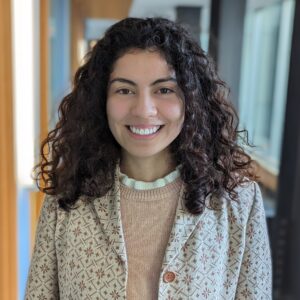 ANNIE GOMEZ
ANNIE GOMEZ
Graduate Program: Materials Science and Engineering
Research Lab: Danielle Tullman-Ercek
Please describe your NRT research project.
In my NRT research project, I employ a dual approach involving All-Atom molecular simulations and validation assays. The primary objective is to gain insights into the assembly process of the 1,2 Propanediol Utilization Microcompartment (MCP). This understanding serves as a foundation for designing experiments aimed at mutating the MCP to alter its morphology. The goal is to enable the encapsulation of biomolecules beyond their native enzymes.
What do you hope to learn?
I hope to bridge the knowledge gap between fundamental biophysics and its direct application in my experiments, establishing a reciprocal relationship.
What potential impact could your project have on society?
The potential impact of my project on society is the development of a biodegradable bioreactor and versatile drug delivery vehicles for a range of biotechnological applications.
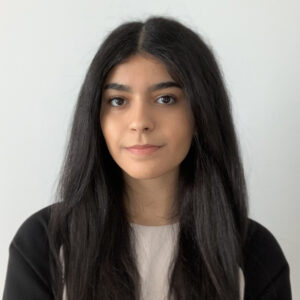 MARAM NAJI
MARAM NAJI
Graduate Program: Chemical & Biological Engineering
Research Lab: Julius Lucks
Please describe your NRT research project.
I am utilizing cell-free systems to screen for synergistic antibiotic combinations that target different components of transcription. Upon finding successful hits in cell-free, I will study these combinations in vivo to find promising, clinically relevant antibiotic combinations.
What do you hope to learn?
I am hoping to uncover the challenges in translating results from a molecular scale to a cellular scale. Cell-free assays are simple and quick to set up, though I do not know how results in cell-free will be replicated in cellular systems where there are many more biomolecular components that may affect and possibly hinder a drug’s impact.
What potential impact could your project have on society?
Antibiotic-resistant infections are becoming more prevalent and threatening with each year, and many in the infectious diseases field are pushing toward using antibiotics in combination to mitigate resistance against individual antibiotics. If successful, this project could produce a simple method for screening numerous antibiotic combinations, expediting the search for new, effective combinations to address antibiotic resistance.
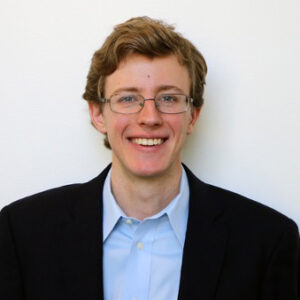 ZACHARY SHAVER
ZACHARY SHAVER
Graduate Program: Interdisciplinary Biological Sciences Graduate Program / Chemical & Biological Engineering
Research Lab: Michael Jewett/Neha Kamat
Please describe your NRT research project.
The goal of my project is to improve the design and production of glycoconjugate vaccines, a particular type of vaccine that has been used to prevent infection by highly virulent bacterial pathogens, such as Streptococcus pneumoniae. I use cell-free protein synthesis to assess vaccine design characteristics and engineer these vaccines to produce enhanced immune responses.
What do you hope to learn?
There is currently a limited understanding of glycoconjugate vaccine design variables, including choice of carrier protein and location of glycan attachment, that result in effective vaccines. I hope to learn which variables, when optimized, result in the strongest immune responses to inform the design of future vaccines.
What potential impact could your project have on society?
The knowledge gained from this project could be used to design highly immunogenic glycoconjugate vaccines against a variety of bacterial pathogens, including those untargeted by current vaccines. Producing these vaccines in cell-free systems may also enable them to be synthesized inexpensively in resource-limited settings.
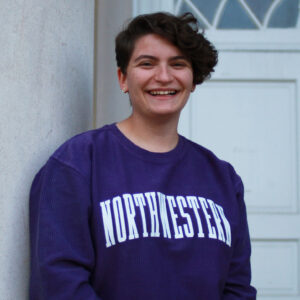 KEREN SNEH
KEREN SNEH
Graduate Program: Biomedical Engineering
Research Lab: Prindle
Please describe your NRT research project.
I am using engineered bacteria to create continuous monitoring tools and targeted drug delivery methods for Inflammatory Bowel Disease (IBD).
What do you hope to learn?
I’m hoping to improve how I approach new synthetic biology problems by using the scales framework of SynBAS. This approach will help me break down to problem into each necessary piece.
What potential impact could your project have on society?
Current IBD treatment options suffer from a lack of robust non-invasive monitoring tools and a lack of targeted drug delivery options. My project aims to tackle both gaps and provide patients both with better diagnostic tools and improved therapeutics that target inflammation where and when it is happening.
by Lisa La Vallee
